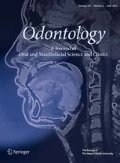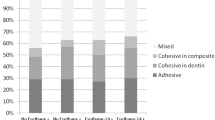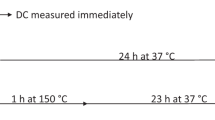Abstract
This study evaluated the effect of the combination of two dimethacrylate-based monomers [bisphenol A diglycidyl dimethacrylate (BisGMA) or bisphenol A ethoxylated dimethacrylate (BisEMA)] with diluents either derived from ethylene glycol dimethacrylate (ethylene glycol dimethacrylate, diethylene glycol dimethacrylate, triethylene glycol dimethacrylate, tetraethylene glycol dimethacrylate) or 1,10-decanediol dimethacrylate (D3MA) on network characteristics and mechanical properties of neat resin and composite materials. The degree of conversion, maximum rate of polymerization and water sorption/solubility of unfilled resins and the flexural strength and microhardness of composites (after 24 h storage in water and 3 months storage in a 75 vol% ethanol aqueous solution) were evaluated. Data were analyzed with two-way ANOVA and Tukey’s test (α = 0.05). The higher conversion and lower water sorption presented by BisEMA co-polymers resulted in greater resistance to degradation in ethanol compared with BisGMA-based materials. In general, conversion and mechanical properties were optimized with the use of long-chain dimethacrylate derivatives of ethylene glycol. D3MA rendered more hydrophobic materials, but with relatively low conversion and mechanical properties.



Similar content being viewed by others
References
Ferracane JL, Greener EH. The effect of resin formulation on the degree of conversion and mechanical properties of dental restorative resins. J Biomed Mater Res. 1986;20(1):121–31.
Bouschlicher MR, Rueggeberg FA, Wilson BM. Correlation of bottom-to-top surface microhardness and conversion ratios for a variety of resin composite compositions. Oper Dent. 2004;29(6):698–704.
Sideridou I, Tserki V, Papanastasiou G. Study of water sorption, solubility and modulus of elasticity of light-cured dimethacrylate-based dental resins. Biomaterials. 2003;24(4):655–65.
Odian G. Principles of polymerization. 3rd ed. New York: John Wiley & Sons; 1994.
Andrzejewska E. Photopolymerization kinetics of multifunctional monomers. Prog Polym Sci. 2001;26(4):605–65.
Gajewski VE, Pfeifer CS, Froes-Salgado NR, Boaro LC, Braga RR. Monomers used in resin composites: degree of conversion, mechanical properties and water sorption/solubility. Braz Dent J. 2012;23(5):508–14.
Bowen RL (1962) Inventor dental filling material comprising vinyl-silane treated fused silica and a binder consisting of the reaction product of bisphenol and glycidyl methacrylate. US Patent 3,066,112, 27 Nov 1962.
Stansbury JW. Dimethacrylate network formation and polymer property evolution as determined by the selection of monomers and curing conditions. Dent Mater. 2012;28(1):13–22.
Peutzfeldt A. Resin composites in dentistry: the monomer systems. Eur J Oral Sci. 1997;105(2):97–116.
Davy KW, Kalachandra S, Pandain MS, Braden M. Relationship between composite matrix molecular structure and properties. Biomaterials. 1998;19(22):2007–14.
Pfeifer CS, Shelton ZR, Braga RR, Windmoller D, Machado JC, Stansbury JW. Characterization of dimethacrylate polymeric networks: a study of the crosslinked structure formed by monomers used in dental composites. Eur Polymer J. 2011;47(2):162–70.
Cramer NB, Stansbury JW, Bowman CN. Recent advances and developments in composite dental restorative materials. J Dent Res. 2011;90(4):402–16.
Feilzer AJ, Dauvillier BS. Effect of TEGDMA/BisGMA ratio on stress development and viscoelastic properties of experimental two-paste composites. J Dent Res. 2003;82(10):824–8.
Lovell LG, Newman SM, Bowman CN. The effects of light intensity, temperature, and comonomer composition on the polymerization behavior of dimethacrylate dental resins. J Dent Res. 1999;78(8):1469–76.
Sideridou I, Tserki V, Papanastasiou G. Effect of chemical structure on degree of conversion in light-cured dimethacrylate-based dental resins. Biomaterials. 2002;23(8):1819–29.
Floyd CJ, Dickens SH. Network structure of Bis-GMA- and UDMA-based resin systems. Dent Mater. 2006;22(12):1143–9.
Atai M, Nekoomanesh M, Hashemi SA, Amani S. Physical and mechanical properties of an experimental dental composite based on a new monomer. Dent Mater. 2004;20(7):663–8.
Beatty MW, Swartz ML, Moore BK, Phillips RW, Roberts TA. Effect of crosslinking agent content, monomer functionality, and repeat unit chemistry on properties of unfilled resins. J Biomed Mater Res. 1993;27(3):403–13.
Krishnan VK, Manjusha K, Yamuna V. Effect of diluent upon the properties of a visible-light-cured dental composite. J Mater Sci Mater Med. 1997;8(11):703–6.
Arima T, Hamada T, McCabe JF. The effects of cross-linking agents on some properties of HEMA-based resins. J Dent Res. 1995;74(9):1597–601.
Park J, Eslick J, Ye Q, Misra A, Spencer P. The influence of chemical structure on the properties in methacrylate-based dentin adhesives. Dent Mater. 2011;27(11):1086–93.
Indrani DJ, Cook WD, Televantos F, Tyas MJ, Harcourt JK. Fracture toughness of water-aged resin composite restorative materials. Dent Mater. 1995;11(3):201–7.
Sideridou ID, Karabela MM, Vouvoudi E. Volumetric dimensional changes of dental light-cured dimethacrylate resins after sorption of water or ethanol. Dent Mater. 2008;24(8):1131–6.
Sideridou ID, Karabela MM. Sorption of water, ethanol or ethanol/water solutions by light-cured dental dimethacrylate resins. Dent Mater. 2011;27(10):1003–10.
Moszner N, Fischer UK, Angermann J, Rheinberger V. Bis-(acrylamide)s as new cross-linkers for resin-based composite restoratives. Dent Mater. 2006;22(12):1157–62.
Goncalves F, Kawano Y, Pfeifer C, Stansbury JW, Braga RR. Influence of BisGMA, TEGDMA, and BisEMA contents on viscosity, conversion, and flexural strength of experimental resins and composites. Eur J Oral Sci. 2009;117(4):442–6.
Charton C, Falk V, Marchal P, Pla F, Colon P. Influence of Tg, viscosity and chemical structure of monomers on shrinkage stress in light-cured dimethacrylate-based dental resins. Dent Mater. 2007;23(11):1447–59.
Ellakwa A, Cho N, Lee IB. The effect of resin matrix composition on the polymerization shrinkage and rheological properties of experimental dental composites. Dent Mater. 2007;23(10):1229–35.
Stansbury JW. Synthesis and evaluation of novel multifunctional oligomers for dentistry. J Dent Res. 1992;71(3):434–7.
Cornelio RB, Wikant A, Mjosund H, Kopperud HM, Haasum J, Gedde UW, et al. The influence of bis-EMA vs bis GMA on the degree of conversion and water susceptibility of experimental composite materials. Acta Odontol Scand. 2013 (in press).
Schmidt C, Ilie N. The effect of aging on the mechanical properties of nanohybrid composites based on new monomer formulations. Clin Oral Invest. 2013;17(1):251–7.
Leprince JG, Palin WM, Hadis MA, Devaux J, Leloup G. Progress in dimethacrylate-based dental composite technology and curing efficiency. Dent Mater. 2013;29(2):139–56.
Stansbury JW, Dickens SH. Determination of double bond conversion in dental resins by near infrared spectroscopy. Dent Mater. 2001;17(1):71–9.
ISO 4049:2000. Dentistry: polymer-based filling, restorative and luting materials. International Organization for Standardization, Geneva. 2000.
Moore JE. Photopolymerization of multifunctional acrylates and methacrylates. Am Chem Soc. 1976;36:747–53.
Anseth KS, Kline LM, Walker TA, Anderson KJ, Bowman CN. Reaction-kinetics and volume relaxation during polymerizations of multiethylene glycol dimethacrylates. Macromolecules. 1995;28(7):2491–9.
Ruyter IE, Svendsen SA. Remaining methacrylate groups in composite restorative materials. Acta Odontol Scand. 1978;36(2):75–82.
Wei YJ, Silikas N, Zhang ZT, Watts DC. Diffusion and concurrent solubility of self-adhering and new resin-matrix composites during water sorption/desorption cycles. Dent Mater. 2011;27(2):197–205.
Ferracane JL. Hygroscopic and hydrolytic effects in dental polymer networks. Dent Mater. 2006;22(3):211–22.
Van Krevelen D. Properties of polymers. 3rd ed. Amsterdam: Elsevier; 1990.
Ferracane JL. Is the wear of dental composites still a clinical concern? Is there still a need for in vitro wear simulating devices? Dent Mater. 2006;22(8):689–92.
Bland MH, Peppas NA. Photopolymerized multifunctional (meth)acrylates as model polymers for dental applications. Biomaterials. 1996;17(11):1109–14.
Ferracane JL. Elution of leachable components from composites. J Oral Rehabil. 1994;21(4):441–52.
Tanaka K, Taira M, Shintani H, Wakasa K, Yamaki M. Residual monomers (TEGDMA and Bis-GMA) of a set visible-light-cured dental composite resin when immersed in water. J Oral Rehabil. 1991;18(4):353–62.
Lemon MT, Jones MS, Stansbury JW. Hydrogen bonding interactions in methacrylate monomers and polymers. J Biomed Mater Res A. 2007;83(3):734–46.
Montes GG, Draughn RA. Slow crack propagation in composite restorative materials. J Biomed Mater Res. 1987;21(5):629–42.
Acknowledgments
The authors would like to express their gratitude to CAPES (Coordination for Enhancement of Higher Education Personnel) for the financial support (PNPD-CAPES 02436/09-4), to Antonio Carlos Lascala for the technical support and to FGM Produtos Odontológicos (Joinville, SC, Brazil) for preparing the experimental composites tested in this study.
Conflict of interest
The authors Nívea R. G. Fróes-Salgado, Vinícius Gajewski, Bárbara P. Ornaghi, Carmem S. Pfeifer, Marcia M. Meier, Tathy Aparecida Xavier and Roberto R. Braga declare that they have no conflicts of interest.
Author information
Authors and Affiliations
Corresponding author
Rights and permissions
About this article
Cite this article
de Godoy Fróes-Salgado, N.R., Gajewski, V., Ornaghi, B.P. et al. Influence of the base and diluent monomer on network characteristics and mechanical properties of neat resin and composite materials. Odontology 103, 160–168 (2015). https://doi.org/10.1007/s10266-014-0153-6
Received:
Accepted:
Published:
Issue Date:
DOI: https://doi.org/10.1007/s10266-014-0153-6




